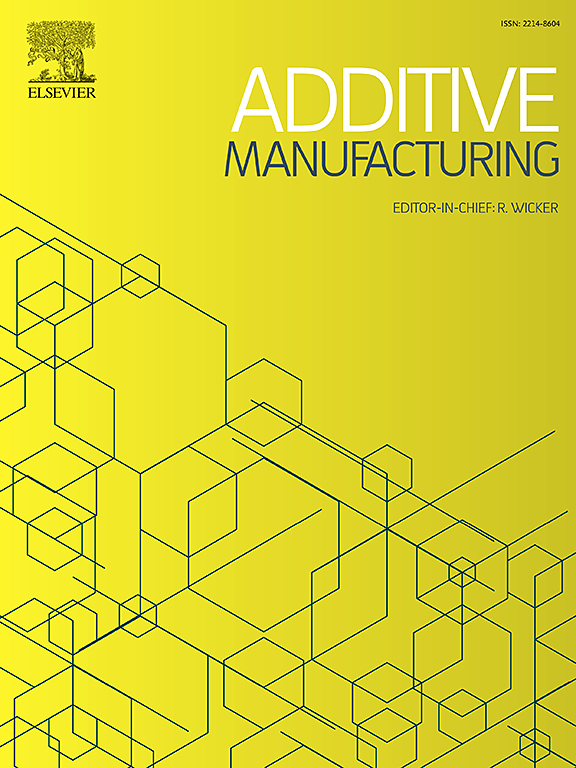通过一种新型的金属盐粘结剂,在原位添加纳米la2o3的情况下喷射出细晶粒的重钨合金
IF 10.3
1区 工程技术
Q1 ENGINEERING, MANUFACTURING
引用次数: 0
摘要
结合剂喷射技术(BJ)在高效率、低成本制造复杂重钨合金(WHA)零件方面具有巨大的潜力。然而,烧结的BJ WHA部件往往面临晶粒粗大和机械性能差的挑战,这可归因于低生坯密度和严格的烧结条件(例如高温或长时间)。在粉末冶金中,氧化物纳米颗粒经常被引入以固定晶界,在烧结过程中限制晶粒生长,从而提高机械性能。本研究通过粘结剂引入氧化纳米颗粒,有效避免了混合不均匀、工艺复杂和杂质引入等问题。La(NO3)3粘结剂的关键成分是水溶性无机金属盐La(NO3)3,在预处理过程中,在基粉中原位生成纳米la2o3(200 nm),以细化W晶粒,提高力学性能。系统研究了La(NO3)3粘结剂对烧结BJ复合材料微观结构和性能的影响,并与商用粘结剂印刷的材料进行了比较。烧结样品的平均W晶粒尺寸为26.85 μm,比普通粘结剂(34.53 μm)细。烧结试样的极限抗拉强度为926.54 MPa,屈服强度为661.72 MPa,分别比普通粘结剂高8.46 %和5.86 %。此外,细晶强化、弥散强化、固溶强化和位错强化对La(NO3)3粘结剂打印的烧结WHAs屈服强度的贡献均有所增强。这项工作为BJ金属材料的晶粒细化和性能增强提供了一条有前途的途径。本文章由计算机程序翻译,如有差异,请以英文原文为准。
Fine-grained binder jetted tungsten heavy alloys with in situ nano-La2O3 addition via a novel metal salt binder
Binder jetting (BJ) holds immense potential for manufacturing complex tungsten heavy alloy (WHA) parts with high efficiency and low cost. However, sintered BJ WHA parts often face the challenges of coarse grains and poor mechanical performance, which can be attributed to low green density and stringent sintering conditions (e.g., high temperature or long duration). In WHA powder metallurgy, oxide nanoparticles are often introduced to pin grain boundaries, limiting grain growth during the sintering process and thereby enhancing the mechanical properties. This work introduced oxide nanoparticles through the binder, which could effectively avoid the problems of uneven mixing, process complexity and impurity introduction. La(NO3)3 binder, the key component of which was La(NO3)3, a water-soluble inorganic metal salt, would generate nano-La2O3 (200 nm) in situ among the base powders during pretreatment, aiming at refining W grains and enhancing mechanical performance. The effects of La(NO3)3 binder on the microstructure and properties of sintered BJ WHAs were systematically investigated and compared with those printed by the commercial binder. The average W grain size of sintered samples was 26.85 μm, finer than that printed by the commercial binder (34.53 μm). The ultimate tensile strength and yield strength of sintered samples were 926.54 MPa and 661.72 MPa, which were 8.46 % and 5.86 % higher than those printed by the commercial binder, respectively. Furthermore, the contributions of fine-grained strengthening, dispersion strengthening, solid-solution strengthening, and dislocation strengthening to the yield strength of sintered WHAs printed by La(NO3)3 binder were all enhanced. This work offers a promising approach for grain refinement and performance enhancement of BJ metallic materials.
求助全文
通过发布文献求助,成功后即可免费获取论文全文。
去求助
来源期刊

Additive manufacturing
Materials Science-General Materials Science
CiteScore
19.80
自引率
12.70%
发文量
648
审稿时长
35 days
期刊介绍:
Additive Manufacturing stands as a peer-reviewed journal dedicated to delivering high-quality research papers and reviews in the field of additive manufacturing, serving both academia and industry leaders. The journal's objective is to recognize the innovative essence of additive manufacturing and its diverse applications, providing a comprehensive overview of current developments and future prospects.
The transformative potential of additive manufacturing technologies in product design and manufacturing is poised to disrupt traditional approaches. In response to this paradigm shift, a distinctive and comprehensive publication outlet was essential. Additive Manufacturing fulfills this need, offering a platform for engineers, materials scientists, and practitioners across academia and various industries to document and share innovations in these evolving technologies.
 求助内容:
求助内容: 应助结果提醒方式:
应助结果提醒方式:


